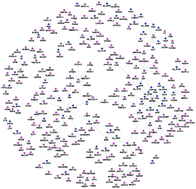Omics and bioinformatics applied to vaccine development against Borrelia†
Abstract
Borrelia burgdorferi is an extracellular spirochete that causes Lyme disease. Currently, no effective vaccine is available for humans and animals except for dogs. In the present study, an extensive bioinformatics pipeline was established to predict new candidates that can be used for vaccine development including building the protein–protein interaction network based on orthologues of experimentally verified protein–protein interaction networks, elucidation of the proteins involved in the immune response, selection of the topologically-interesting proteins and their prioritization based on their antigenicity. Proteomic network analysis yielded an interactome network with 120 nodes with 97 interactions. Proteins were selected to obtain a subnet containing only the borrelial membrane proteins and immune-related host proteins. This strategy resulted in the selection of 15 borrelial targets, which were subjected to extensive bioinformatics analysis to predict their antigenic properties. Based on the strategy applied in this study the proteins encoded by erpX (ErpX proteins, UniProt ID: H7C7L6), erpL (ErpL protein, UniProt ID: H7C7M3) and erpY (ErpY protein, UniProt ID: Q9S0D9) are suggested as a novel set of vaccine targets to control Lyme disease. Moreover, five different tools were used to validate their antigenicity regarding B-cells. The combination of all these proteins in a vaccine should allow improved protection against Borrelia infection.



 Please wait while we load your content...
Please wait while we load your content...